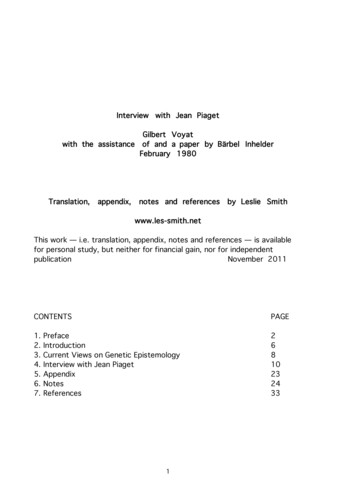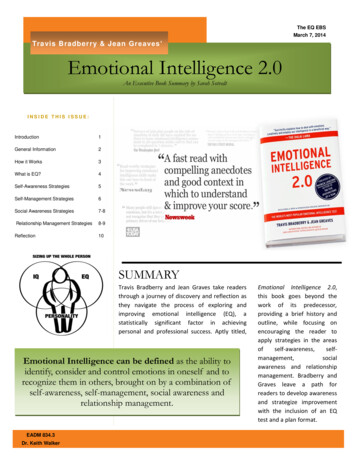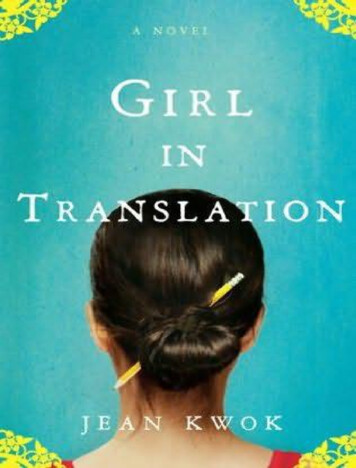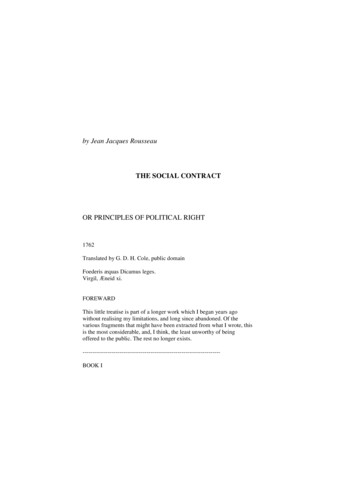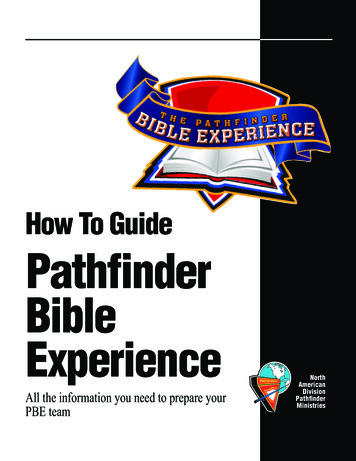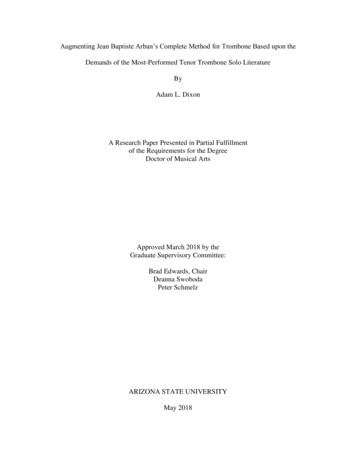
Transcription
Augmenting Jean Baptiste Arban’s Complete Method for Trombone Based upon theDemands of the Most-Performed Tenor Trombone Solo LiteratureByAdam L. DixonA Research Paper Presented in Partial Fulfillmentof the Requirements for the DegreeDoctor of Musical ArtsApproved March 2018 by theGraduate Supervisory Committee:Brad Edwards, ChairDeanna SwobodaPeter SchmelzARIZONA STATE UNIVERSITYMay 2018
2018 Adam DixonAll Rights Reserved
ABSTRACTThis thesis proposes an augmentation of the Complete Method for Trombone byJean Baptiste Arban. Although it is widely considered one of the leading trombonemethod books in the world, a thorough consideration of the demands of most performedsolo literature today reveals serious shortcomings in the Arban Method for preparingtrombonists to encounter such demands as meter and rhythm, keys and tonalities, rangeand endurance, clefs and F-attachment usage. This thesis thus proposes additions for anew version of the Arban Method that better aligns with the playing demands of the mostperformed solo literature today, as compiled by the International Trombone AssociationJournal since 1972.iii
TABLE OF CONTENTSPageLIST OF FIGURES . vCHAPTER1INTRODUCTION . 12A SUMMARY OF THE PLAYING CHALLENGES IMPOSED BY MOSTPERFORMED SOLO LITERATURE FOR TENOR TROMBONE . 53PROPOSED ADDITIONS FOR AN AUGMENTED METHOD BOOK FORTENOR TROMBONE . 254FURTHER SUGGESTIONS FOR AN AUGMENTED ARBAN’S METHOD . 30CONCLUSION . 35REFERENCES . 36APPENDIXA. COMPILED DATA FROM THE INTERNATIONAL TROMBONEASSOCIATION JOURNAL. 38B. SAMPLE SOLO-SPECIFIC LESSON PLANS USING THE ARBAN’SMETHOD . 45C. EXAMPLES PAGES FROM AN AUGMENTED ARBAN’S BOOK (ED.ADAM DIXON) . 50iv
LIST OF FIGURES1. Standard tenor trombone solos as listed in the ITAJ in order of popularity . 62. Stjepan sulek. Sonata (Vox Gabrieli) for trombone & piano. 73. Paul Hindemith. Sonata for Trombone, Movement I . 74. Hindemith rhythm comparison at rehearsal C . 85. Paul Hindemith. Sonata for Trombone, Movement III . 86. Launy Grøndahl. Concerto. Movement III . 97. Launy Grøndahl. Concerto. Movement II. 108. Jacques Castérède. Sonatine. Movement I . 119. Jacques Castérède. Sonatine. Movement I . 1110. Jacques Castérède. Sonatine. Movement III . 1111. High and low ranges within each solo . 1412. Kazimierz Serocki. Sonatina for Trombone and Piano. Mvt. I . 1513. Clefs used within each solo. 1714. Paul Hindemith. Sonata. Movement III . 1715. Lars-Erik Larsson. Concertino. Movement I . 1816. Kazimierz Serocki. Sonatina. Movement I . 1817. Stjepan Sulek. Sonata. 2018. Launy Grøndahl. Concerto. Movement I . 2119. Eugène Bozza. Ballade. Third measure of rehearsal 3 . 2220. Eugène Bozza. Ballade. First measure of rehearsal 16. 23v
CHAPTER 1INTRODUCTIONInitially written for cornet and saxhorn, Joseph Jean-Baptiste Laurent Arban’sGrande méthode complete de cornet à pistons et de saxhorn was released in Parissometime around 1857, as the first published edition contains a copyright date of 1864.1Since the initial publication for trombone, multiple versions have been published and areavailable with specific information regarding the proper technique for playing thetrombone. One of the three standard editions of the Method can be found in the personallibraries of many trombonists, as well as in many conservatories, universities, and privatestudios worldwide. This method book’s historical popularity is well-deserved as itcontains hundreds of exercises covering many aspects of trombone technique as well asinstructional text by respected performers.In 1936 Carl Fischer published the first popular edition of the Method forTrombone entitled Arban’s Famous Method for Slide and Valve Trombone and Baritone.This edition includes commentary by two well-known trombonists, Charles L. Randalland Simone Mantia. Although other editions of the Method for Trombone have beenpublished for other instruments after 1936, it was not until 2002 that Encore Musicreleased a significant revision for tenor trombone. This version, edited by Joseph Alessi,Dr. Brian Bowman, and Wesley Jacobs, is entitled Arban Complete Method forTrombone & Euphonium. More recently, Carl Fischer republished their 1936 edition with1Yeo, Douglas. Review of Jean Baptiste Arban. Revised for Trombone by Charles L.Randall and Simone Mantia. New Edition edited by Alan Raph. International TromboneAssociation Journal 40, no. 4 (October 2015): 49-50.1
additional edits and commentary by Alan Raph in 2013 while keeping the original textfound in the 1936 edition. Each of the three editions of the Method for Trombone are nolonger adequate as the instructional text provided by each editor is tailored for musiciansof past generations and does not address the needs of the most-performed solo literature(see appendix A).2Joseph Jean-Baptiste Laurent was born in Lyons, France, on February 28th, 1825.He was accepted into the Paris Conservatoire under the tutelage of Francois Dauverné atthe age of sixteen. While at the Conservatoire, Arban won the Premier Prix in 1845.Following the completion of his studies, Arban’s career included service in the militaryand other professional employment. He became renowned for both his lyrical andtechnical playing, especially for his abilities with multiple tonguing.The Method for Trombone originated from Arban’s Grande Méthode Complete deCornet à Pistons et de Saxhorn, which was written while Arban was Professor ofSaxhorn at the Ecole Militaire. Arban was at this position when he petitioned the schoolto form a cornet and trumpet class at the Paris Conservatoire, as both instruments werebecoming recognized as versatile solo instruments. Arban began to teach the cornet andtrumpet at the Conservatoire in January 1869 and stayed there until April 1874 when heleft to conduct in St. Petersburg. He returned to the Paris Conservatoire in late 1880to again teach the cornet. He would remain in Paris until his death on April 9, 1889. 32Consolidated from the literature section of the International Trombone Association Journal; aquarterly journal published worldwide, this information is not complete as the data relies ontrombonists submitting program information to the journal. It does, however, provide areasonably accurate representation of the most popular works for the tenor trombone.Edward H. Tarr, “Arban, (Joseph) Jean-Baptiste (Laurent),” Oxford Music Online, Grove MusicOnline, last modified January 20, 2001, accessed January 16, 201832
Carl Fischer published the first popular edition of the Method for Tromboneedited by Simone Mantia and Charles L. Randall in 1936. In this and subsequent editionsof the Method for Trombone, thirty-one sections cover many of the fundamentals neededto play standard solo literature well. These sections focus primarily on major scalepatterns with few interjections of minor scale exercises. Some of these sections focus onleaps, such as interval studies, slurs, and chord studies. Although the exercises arebeneficial in developing common musical intervals, they are still based primarily ondiatonic scale patterns. Furthermore, all of the exercises stay within a limited range thatfalls between E2 and a B-flat 4.Although the Method for Trombone no longer helps develop all of the skillsneeded for advanced trombonists to adequately play most standard solo repertoire,particularly repertoire composed since 1972, it does serve as an excellent resource andmethod book for many beginners who work in a limited range and are tacklingfundamentals usually found in high school level repertoire. Once a trombonist reachesthis level, they might be asked by a private teacher to purchase additional method booksto assist in the development of skills not found in the Method for Trombone.4 It is theauthor’s belief that the large number of method books available on the market is due, inpart, to the shortcomings of the currently available editions of the Method. Although it isnot the purpose of this paper to exhaustively list these other books, salient examples 592630-e-0000001162).4Additional method books may include Vladislav Blazhevich’s School for Trombone inClefs, Reginald Fink’s Studies in Legato, Georg Kopprasch’s Sixty Selected Studies forTrombone, and Max Schlossberg’s Daily Drills and Technical Studies for Trombone.3
be presented at times. This paper proposes a more efficient single-volume solution tocover the repertoire challenges that trombonists face in the most played trombone solos.(For the remainder of the paper, the Method for Trombone will be simply referred to asthe Method.)4
CHAPTER 2A SUMMARY OF THE PLAYING CHALLENGES IMPOSED BY MOSTPERFORMED SOLO LITERATURE FOR TENOR TROMBONEThe exercises found within the Method are based on the demands of 19th centurytrumpet and cornet literature. Editors have adapted these exercises for the trombone bytransposing the book to bass clef. A study of the technical demands of the mostperformed tenor trombone solo literature quickly reveals challenges not addressed by thecurrent edition of the Method.The chart in figure 1 represents the most-performed solo works for the tenortrombone. The list is presented in order of popularity as defined by frequency ofappearance on student recital programs according to the International TromboneAssociation Journal (ITAJ). Since this list is dependent on voluntary submissions to theJournal, it cannot be considered exhaustive. However, it is a reasonable representationfrom which to derive a list of standard solo literature. A complete listing can be found inappendix A.5
Title:1. Sulek, Sonata (1975)2. Hindemith, Sonata (1941)3. Grøndahl, Concerto (1921)4. Larsson, Concertino (1955)5. Castérède, Sonatine (1957)6. Serocki, Sonatina (1955)7. Saint-Saëns, Cavatine (1915)8. David, Concertino (1837)9. Tomasi, Concerto (1956)10. Bozza, Ballade (1944)Figure 1. Standard tenor trombone solos as listed in the ITAJ in order of popularity.Meterand2.RhythmFigureStjepan Sulek. Sonata (Vox Gabrieli) for trombone & piano.Figure 3. Standardtenor trombone solos as listed in the ITAJ in order of popularity.Each of the standard solo works features compound time signatures not coveredby the Method. Out of the works listed above, five begin in a compound meter other thanFigure 2. Stjepan Sulek. Sonata (Vox Gabrieli) for trombone & piano.6/8 time. The five remaining solos consist of simple time signatures, three of which haveFigure 4. Paul Hindemith. Sonata for Trombone, Movement I.Figure 5. Stjepan Sulek.the quarter note equaling the beat and the remaining two have the dotted half-noteSonata (Vox Gabrieli) for trombone & piano.Figure 6. Standard tenor trombone solos aslisted in the ITAJ in order of popularity.receiving the beat. The Method only prepares the student for three of the ten timesignatures found within these solos. Within the Method, there are just twenty-sixFigure 7. Stjepan Sulek. Sonata (Vox Gabrieli) for trombone & piano.Figure 8. Standardexercises writtenin 2/2time. ses aretenortrombonelisted in theITAJ in orderof popularity.listed in the multiple tonguing sections. The first exercise in 2/2 time is found on pagefifty of the 1936 Carl Fischer edition.In the case of the most popular solo, Stjepan Sulek’s Sonata (1975), we can see infigure 2 the first time signature marked as 3/2 time, a meter possibly chosen to clarify6
notation of the intricate piano accompaniment. Within the Sonata, there are only fourmeasures employing a quarter note pulse; the rest is a mixture of 2/2, 3/2, 4/2, or 6/2.Because the Method consists of just twenty-six exercises in 2/2 time, it will notadequately prepare students to play this solo.Figure 2. Stjepan Sulek. Sonata (Vox Gabrieli) for trombone & piano.Figure 9. Paul Hindemith. Sonata for Trombone, Movement I.Figure 10. StjepanSulek. Sonata (Vox Gabrieli) for trombone
Augmenting Jean Baptiste Arban’s Complete Method for Trombone Based upon the Demands of the Most-Performed Tenor Trombone Solo Literature By Adam L. Dixon A Research Paper Presented in Partial Fulfillment of the Requirements for the Degree Doctor of Musical Arts Approved March 2018 by the Graduate Supervisory Committee: Brad Edwards, Chair Deanna Swoboda Peter Schmelz ARIZONA
